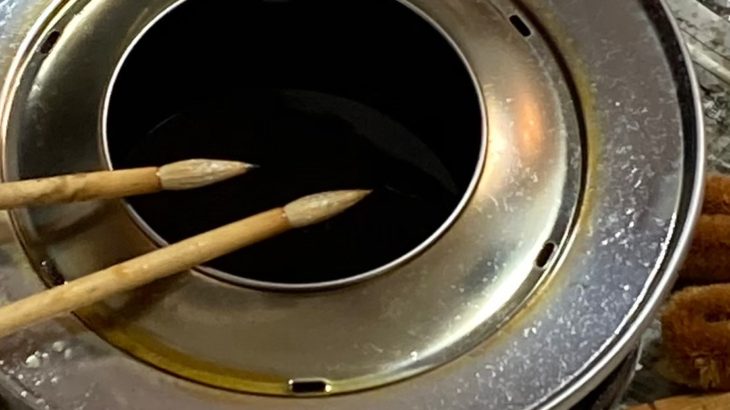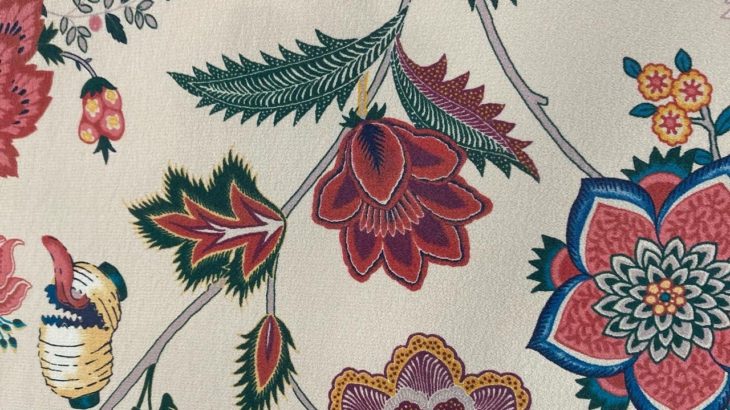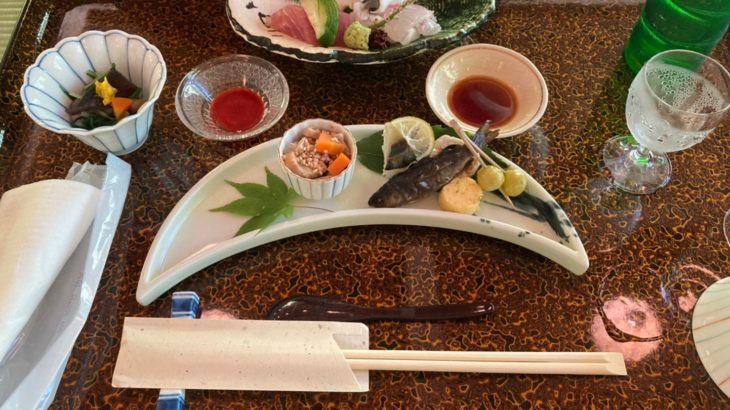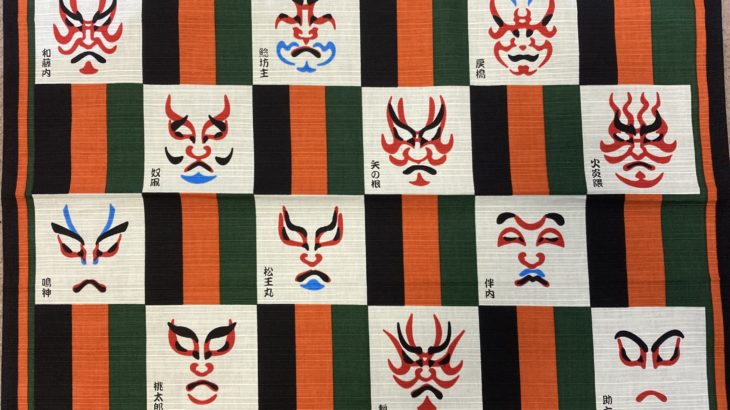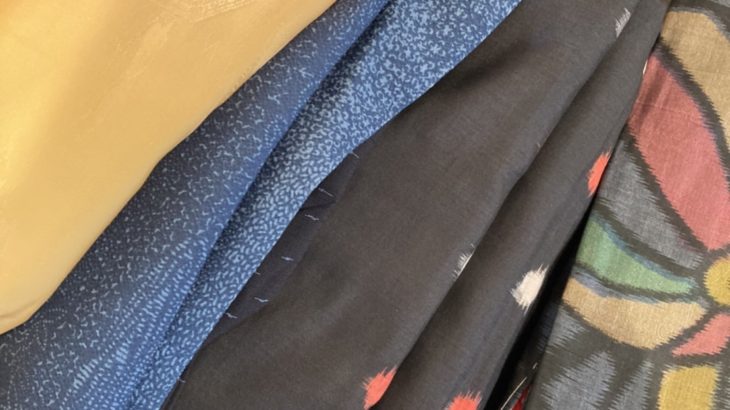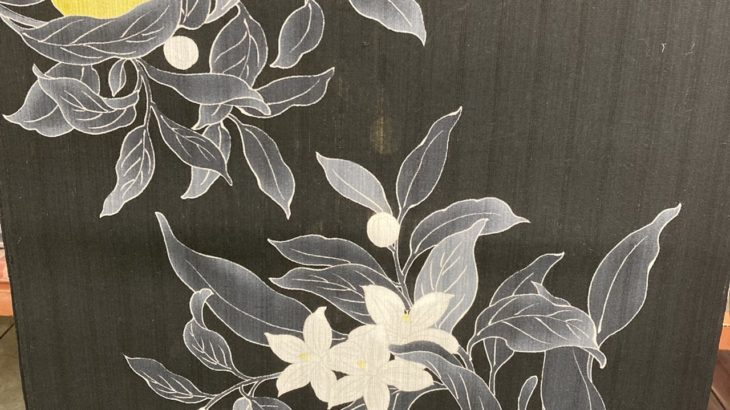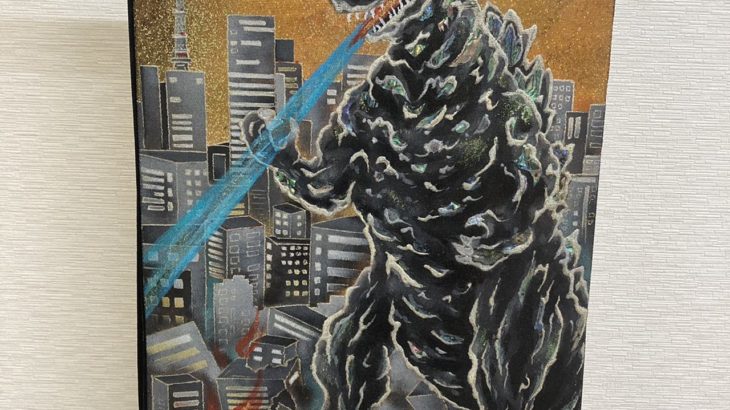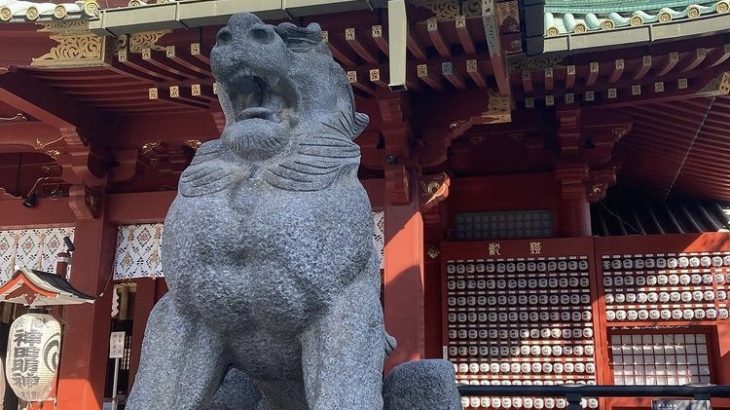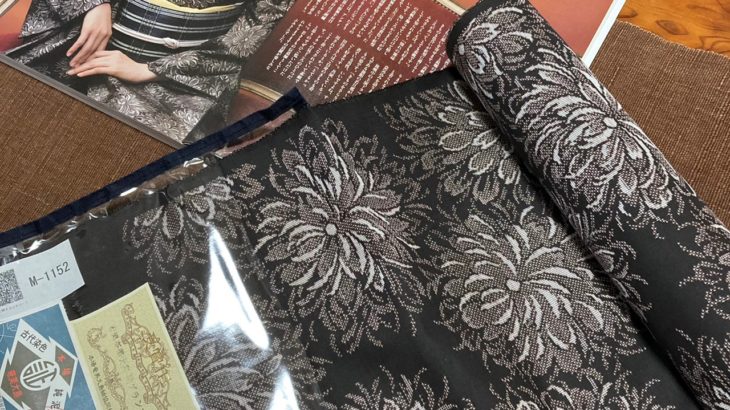Hello, this is Shinji from Warashibechoja JP. The New Year has begun… We are gradually gaining recognition through Instagram, and we are busy with inquiries from our customers. As the Chinese zodiac sign for this year is a rabbit, I hope that 2023 will be a year of leaps and bounds.In the midst of all this, I had the opportunity to visit the studio of a kimono artist who has been a good friend of mine for a long time, and experience a part of the wax-dyeing process. What is Batik? It is a dyeing method using wax that is used all over the world, and is said to have been used in Japan since the Nara period (710-794). It is said that the cloth was hardened with wax to prevent dyeing, then the surrounding area was dyed and the wax was removed to add patterns. Creation procedure 1) Use a brush to lay down the wax on the dyed-out area. The wax will harden quickly at this point, so it is a game of speed to write before it hardens. 2) The area covered with wax is dyed with an anti-dyeing agent, so the surrounding area is dyed. In […]
こんにちは、わらしべ長者JPのシンジです。新年が明けました…。Instagramで知名度も少しずつ上がり、お客様からの問い合わせで追われる日々を送っています。今年の干支はうさぎという事もあり、2023年は飛躍の年になれればと思います。そんな中、以前から仲良くさせて頂いている着物作家の先生の工房に行かせて頂き、ろうけつ染めの一部を体験してきました。 ろうけつ染めとは 世界中で行われている蝋を使う染色方法で、日本では奈良時代から行われていたと言われています。布地を蝋で固め防染したのちに周りを染めてから蝋をとる事で文様を付けたと言われています。 作成手順 ① 筆を使い、染め抜きの部分を蝋で伏せていきます。この時、すぐに蝋は固まってしまうので固まる前に書いていくので、スピードとの勝負になります。 ② 蝋で伏せた部分が、防染されて染まらないので、周りの部分を染めていきます。刷毛を使って挽き初めを行う場合が多いですが、今回は小さな刷毛を使いぼかし染めを行いました。 ③ 薬剤を使い蝋を取り除き、今度は蝋で伏せて染まっていなかった所の周りを蝋で伏せていき、染め抜いた部分を染めていきます。 ④ また、薬剤を使い蝋を取り除いていき完成します。多いものではこの工程を20回程繰り返すものもあります。 ぼかし染め 今回の工房の先生のご厚意で難しいと言われているぼかし染めを体験させて頂きました。下手に行うと四角く染まってしまうので、とても難しい作業になります。コツは、全体を霧吹きを使い薄く水で湿らせてから染料をのせて刷毛で広げていきます。とても難しい作業になります。先生に、見本を見せて頂きましたが、さすが匠の技でした。 蝋の調合 今回は時間の関係で先生に行ってもらいましたが、季節や気温、湿度によって蝋の調合を変えていきます。例えば、冬は伏せた蝋が割れない様に少し粘り気のある柔らかな蝋を使います。逆に夏は、蝋がくっつかない様に硬めの蝋を使います。パラフィンワックスと蜜蝋等を混ぜて使う事が多いですが、その工房によって配合は少し異なります。調合には長い経験が必要になります。 今回は、ろうけつ染めをご紹介させて頂きました。今後も、色々な工房にお邪魔させて頂こうと思いますので、お楽しみにして下さい。 Instagram:わらしべ長者.JPECサイト: Warashibechoja.jp
Hello, this is Shinji from Warashibe Choja JP. This time, I would like to write about Japanese yokai, which were very popular on Instagram. Do you know the word “yokai”? Yokai It is said that the word was introduced in the Nara period (710-794) to mean “strange phenomenon. Plagues, typhoons, and other disasters, which are now scientifically understood, were strange phenomena whose causes were unknown at that time. It is said that the people of that time changed the term to “a person who causes strange phenomena”. Types of Yokai Yōkai are also called yokai (monsters), mononoke (monsters), or mamono (demons), but when translated into English, yōkai are sometimes referred to as monsters.Yokai = monsters in the Edo period (1603-1867), and my personal favorite yokai are often those that inhabit “objects”. ① Ghost lantern If the lanterns are not cared for and left unattended for many years, they turn into “ghost lanterns. It is said to be a yokai that frightens people, but since the torn lantern looks like an open mouth, it may have been created by a rumor that spread at the time to keep children from playing outside at night. ② Gasyadokuro It is a Japanese yokai […]
Hello, this is Shinji from Warashibe-Choja.jp. The other day, I went to a kawadoko in Kyoto. Maiko came again this year and showed us their dance and we had a great time talking with them about many things. I am happy that many of you read my article about maiko in last year’s issue and some of you subscribed to my Youtube page. This year, I would like to write about this pig I found on the riverbed. 1. Kayari-buta I didn’t know that mosquito coil pig had a name!” I think some of you may be thinking, “I didn’t know that mosquito coil pig had a name! It is a ceramic figurine also called “Katori-buta,” which is used by burning mosquito coils inside. Why a pig? There are some theories. There are several theories, but here is the origin. source1 There are several theories, but there is a story said to have spread in Aichi Prefecture. Tokoname City in Aichi Prefecture was the largest producer of clay pipes in Japan from the Meiji Era to the Showa Era, and the story is still passed down to craftspeople today.A long time ago, a pig farmer was troubled by mosquitoes perching on […]
Hello, this is Shinji from Warashibe-choja.jp. Summer is approaching, and for the first time in three years, fireworks displays and summer festivals will be held in various places in Japan. I think it is a good idea to go out in a kimono or yukata this summer.In this issue, I would like to introduce the best accessories for kimonos and yukatas. 1、Han-Eri Han-Eri is to be attached to a long undergarment to be worn under a kimono. Recently, more and more people wear a hanbira under a yukata (summer kimono) as a simple kimono.In summer, beaded Han-Eri, which is easy to clean, and lace Han-Eri, which looks cool, are also popular.There are also many stylish Han-Eri that can be worn with non-summer kimonos. 2、Obidome Obidome is an ornament that is placed through the obijime so that it comes to the front of the obi.There are beautiful jewel-like obidome, wooden obidome, and authentic wagashi-style obidome made of colored clay by a former wagashi (Japanese confectionery) craftsman. The sparkling and shiny ones can be worn with formal kimonos, while the others can be worn with everyday clothes. Some overseas customers buy them as pendant tops as well. 3、Zori ( = Japanese footwear […]
Hello, this is Shinji from Warashibechoja JP. It is getting warmer and warmer, the cherry blossoms have started to bloom, and it is a good season to go out in kimonos. My Instagram, which I started last year, is going well and I now have more than 1,200 followers. Thank you very much. This time, we have received many questions from our customers, so we would like to write an article based on the mutual thoughts of a recycled kimono shop and a kimono shop dealing with new kimonos. 1、Difference between recycled kimono and new kimono 1, Size Generally, there is an image that recycled kimonos are old, but in fact, there is a problem before that. It is the width of the fabric. The width of an old kimono is about 9″5″ (=about 36 cm), but the width of a recent kimono is generally 1 shaku (=37.8 cm) or more. The longest kimono is 1 shaku 1 sun (= translates to 41.5 cm).Japanese people are said to have been small in the past, but this is not true. The way to measure the length of the Yuki (hand length in kimono) was different, and many old kimono were short. […]
Hello, this is Shinji from Wareshibe-choja.jp. This time, I would like to talk about yukata, a Japanese summer tradition. It is only March, but in order for consumers to see yukata, manufacturers prepare them at the end of last year, and in March, retailers go to wholesalers and manufacturers to stock them, which is the flow of the kimono industry. Recently, due in part to the impact of the H1N1 influenza, the main trend has been to produce to order in order to avoid overstocking. 1, History of Yukata During the Heian period in Japan, the main type of bath was a steam bath, and people bathed in a linen kimono worn at that time. In the Kamakura period, people bathed in loincloths and underwear called yumonji, and in the Azuchi-Momoyama period, people began to bathe naked. In the Edo period (1603-1867), after the spread of public bathhouses, the common people began to wear a cotton kimono called yukatabira to absorb excess water after bathing, which is said to have been the beginning of the yukata. 2, Spread of yukata In the Edo period (1603-1867), yukata, which were worn after taking a bath or as a nightgown, gradually came to […]
Hello, this is Shinji from Warashibe-choja.jp. Speaking of Nishijin, it is the largest obi production area in Japan.As I sometimes advertise on Instagram (@warashibe-choja.jp), I’ve been working with the craftsmen of Nishijin-ori to find ways to introduce Nishijin-ori to the world. This time, I would like to introduce some of the things we are working on with the craftsmen of Nishijin. History of Nishijin As I have mentioned before, after the Onin War (1467-1477), weavers who had scattered to various places returned to Kyoto and resumed weaving. The name “Nishijin” came from its location west of the Kyoto Imperial Palace. Types of Weaving Weaving has been flourishing since the 5th century, and after the Onin War, the area was called Nishijin, and this year marks 555 years since then. During that time, many techniques have been born and disappeared. I would like to introduce some of the techniques and weaving methods that still remain today. Tsuzure-ori The origin of Tsuzure-ori is said to be in Egypt, where Tsuzure-ori clothing was found in a royal tomb in the 15th century BC. It is said to have been introduced to Japan in the Asuka period, but after that, it was no longer […]
Hello, this is Shinji from Warashibecho.jp. This time, I’d like to talk about the Japanese New Year.Unlike the atmosphere overseas, Japanese New Year’s Day at once enhances the atmosphere of preserving old traditions. Today, I’d like to introduce some of them to you. 1, Japanese New Year In Japan, January 1st to 3rd is called San-ga-nichi, and many people take the day off from work. Nowadays, large supermarkets and department stores are open, but in the past, most stores were closed.The hectic atmosphere at the end of the year suddenly turns into a quiet atmosphere. 2, New Year’s decoration On New Year’s Day, we decorate the front door with ornaments called “Shimenawa” and “Kadomatsu”, and we also decorate the inside of the house with “Kagamimochi” (mirror rice cakes). These decorations are used as markers and offerings to Toshigami-sama ( the New Year’s god ), who is said to go around the houses to bring good fortune for the year. 1) Kadomatsu A Kadomatsu is decorated with three lucky charms, “Syo-chiku-bai”: a pine tree whose leaves never fall off throughout the year, a bamboo tree that grows quickly and has a strong life force, and a plum tree that blooms in […]
Hello, this is Shinji from Warashibe Chosha JP. This time, I went to Amami Oshima to study how Oshima tsumugi is made.I talked to a craftsman who actually makes Oshima tsumugi kimonos. Oshima tsumugi is a plain weave kimono made in Kagoshima Prefecture. There are many types of Oshima pongee, including mud Oshima, indigo Oshima, white Oshima, and colored Oshima. This time, I would like to introduce you to the authentic Amami Oshima mud Oshima. 1. What is Oshima tsumugi? Oshima tsumugi, known as one of the three major pongees in Japan, is characterized by its lightness and durability. The yarn is yarn-dyed to express really fine patterns.The yarn is dyed in the boiling water and mud fields of the tehchigi (Raphiolepis umbellata). A chemical reaction between the tannic acid in the water and the iron in the mud creates a black color that is unique to Oshima tsumugi. 2, the prestige of Oshima tsumugi As I will explain later in this article, Oshima tsumugi is a very expensive fabric that requires a lot of work. The price of a kimono is not necessarily the same as its style, and Oshima tsumugi is more like jeans in terms of clothing. […]
